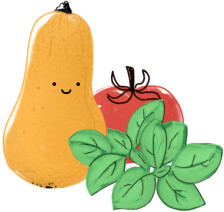Indianerbanane 'Prima 1216'

Variety
Indianerbanane 'Prima 1216'
created by Alex&Sempi at 15.02.2025
Features
Resistances
cold tolerant
resistant
disease resistant
Little susceptible
robust
Winter hardy
Taste
exotic
Pineapple aroma
Banana aroma
mango aroma
Melon aroma
creamy
very aromatic
Fruit shape
round-oval
medium to large
very large
Growth habit
growth habit: pyramidal
tree
large shrub
growth habit: upright
weak growth
lifespan: perennial
self-fruiting
Cold germination
leaves: Deciduous
seed-fixed: yes
root type: deep-rooted
Location
planting: outdoor
light: sunny to semi-shady
Heat requirement: high
Soil: permeable soil
soil moisture: no waterlogging
Fertilization: single dose of compost
Fertilization: nutrient-rich
fertilization: humus-enriched
Soil: Well fertilized
soil moisture: moist
Fertilization: moderately nutrient-rich
Soil: medium-heavy
Water: regularly
soil moisture: not too dry
Soil: sandy to loamy
Color
leaves: Autumn leaf coloration
Season Overview
Planting
Harvest
Harvest
J
F
M
A
M
J
J
A
S
O
N
D
1ST YEAR
FOLLOWING YEARS
Description
The Indian banana / Papau is a real exotic among woody plants! However, (bot.) Asimina triloba is not for impatient gardeners, as the first flowers can only be expected on the plant after around three years. The exotic fruits only develop from them if there is a suitable pollinator nearby. As the plants of this species are dependent on cross-pollination, it is advisable to combine two different varieties. During the flowering period in May, attractive purple bell-shaped flowers appear on this shrub. They are a real eye-catcher with rarity value! The Indian banana / Papau is a must for all garden owners who are looking for something out of the ordinary. The shrub is also known as Pawpaw or three-lobed Papau. It reaches a height of up to 400 cm. The crown of Asimina triloba is narrow and can be kept to a width of around 250 cm with regular pruning. The plant branches out well and produces new shoots of around 30 cm each year. The flowers appear on them before the leaves emerge. When, after a few years in a sheltered and sunny spot in the garden, the time has come for the fruits to form, the joy is great! The fall fruits of the Indian banana / Papau develop from the ovaries, of which each flower contains several. The fruits of Asimina triloba are reminiscent of avocados and have a greenish to yellow-green skin color, they reach a weight of 300 g and a length of 10 cm.
Non hybrid
Frostproof
Growing tips
The three-lobed papaw requires a humus-rich soil that should always be sufficiently moist. This plant is also suitable for growing in containers, which makes it easier to overwinter in the first few years. This is because the Indian banana / papau only reaches its excellent winter hardiness of up to around -25 °C when the trunk is sufficiently developed. Young plants of this species are considered frost-sensitive and the gardener must protect them from frost. To its delight, the Pawpaw is generally particularly easy to care for and diseases and pests are hardly known to affect it. A good choice for all lovers of rare woody plants.
Details
Light requirement
Sunny
Water requirement
Moist
Soil
Medium (loamy)
Nutrient requirement
High
Dark germinator
Germination temperature
20 - 22 °C (Degrees Celsius)
Plant distance
250 cm
Row spacing
250 cm
Seeding depth
2 cm
Antagonistic Plants
Broccoli
Broccoli raab / Stem cabbage / Cima di rapa
Brussels sprouts
Cabbage (Cabbage)
Cabbage (Pointed cabbage)
Cabbage (red cabbage)
Cabbage (Savoy cabbage)
Cauliflower
Collard greens
Collard greens (Kale)
Collard greens (Tuscan kale / Dinosaur kale / Palm tree kale)
Fennel
Florence fennel / Finocchio
Gemüsekohl - Kai-Lan / Chinesischer Brokkoli
Kohlrabi / German turnip / Turnip cabbage
Lovage
Mint
Napa cabbage / Chinese cabbage
Potato
Rosskastanie
Walnut family
Diseases
Root Rot
Black spot of roses
Grey mold
Angular leaf spot of cucumber
Powdery mildews
Pests
Mealybugs
Thrips
Spider mites
Spotted wing drosophila
Aphids